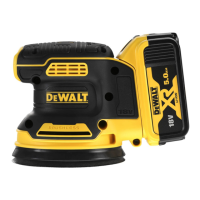32
ENGLISH
mental abilities; lack of experience, knowledge or skills
unless they are supervised by a person responsible for their
safety. Children should never be left alone with thisproduct.
ASSEMBLY AND ADJUSTMENTS
WARNING: To reduce the risk of serious personal
injury, turn tool off and disconnect battery pack
before making any adjustments or removing/
installing attachments or accessories. An accidental
start-up can causeinjury.
WARNING: Use only
battery packs andchargers.
Inserting and Removing the Battery Pack
from the Tool (Fig. C)
NOTE: Make sure your battery pack
7
is fullycharged.
To Install the Battery Pack into the Tool Handle
1. Align the battery pack
7
with the rails inside the sander's
battery port (Fig. C).
2. Slide it into the battery port until the battery pack is firmly
seated and ensure that you hear the lock snap intoplace.
To Remove the Battery Pack from the Tool
1. Press the release button
8
and firmly pull the battery pack
out of the batteryport.
2. Insert battery pack into the charger as described in the
charger section of thismanual.
Fuel Gauge Battery Packs
Some
battery packs include a fuel gauge which
consists of three green LED lights that indicate the level of
charge remaining in the batterypack.
To actuate the fuel gauge, press and hold the fuel gauge button.
A combination of the three green LED lights will illuminate
designating the level of charge left. When the level of charge
in the battery is below the usable limit, the fuel gauge will not
illuminate and the battery will need to berecharged.
NOTE: The fuel gauge is only an indication of the charge left on
the battery pack. It does not indicate tool functionality and is
subject to variation based on product components, temperature
and end-userapplication.
Attaching Sanding Discs (Fig. D)
Your sander is designed to use 125 mm sanding discs
10
with
an 8-hole dust extraction pattern. Sanding discs for the DCW210
attach with hook andloop.
To Attach Sanding Disc to the Sanding Pad
(Fig.D)
1. Turn the sander over so that the sanding pad
6
is
facingupward.
2. Clean the dust from the sanding pad
6
face.
3. Hold the pad with one hand to keep it fromrotating.
4. With the other hand, align the holes and place the sanding
disc
10
directly on top of thepad.
NOTE: These sanders are not to be used in drywall applications.
Using a sanding screen (e.g., screen used for sanding drywall)
directly on the hook and loop pad will not hold and will damage
the hooks on the pad. The hooks on the pad will wear very
rapidly if left in contact with the work surface while the tool
isoperating.
Switch (Fig. A)
To turn the unit on, depress the side of the dust-protected
switch
1
that corresponds to the symbol “I”. To turn the tool
off, depress the side of the switch that corresponds to the
symbol“O”.
Speed Control Dial (Fig. A)
The speed control dial
2
, shown in FigureA, allows you
to increase or decrease speed from 8000–12000 Orbits Per
Minute. The optimal speed setting for each application is very
much dependent on personal preference. Generally, you will
want to use a higher setting on harder materials and a lower
setting on softer materials. Material removal rate increases as
speedincreases.
Dust Extraction (Fig. A, E, G)
WARNING: Since woodworking with a sander produces
dust, always install a dust bag designed in compliance
with the applicable directives regarding dustemission.
WARNING: Do not use a dust bag or vacuum extractor
without proper spark protection when sandingmetal.
Your sander has two dust extraction methods: a built-in port
3
which allows either the supplied dust bag
4
or a shop vacuum
system to be connected; and a dust skirt (
11
, Fig.G). The
built-in port utilizes the
airlock connection making
it compatible with the
dust extractor and airlock
accessoryDWV9000.
To Attach the Dust Bag
1. While holding the sander, fit the dust bag collar
5
to the
dust port
3
as shown in FigureE.
2. Turn the collar
5
clockwise to lock the dust bag
4
inplace.
To Empty the Dust Bag
NOTE: Be sure to wear approved eye protection and approved
dust mask when performing thisprocedure.
For efficient dust extraction, empty the dust collector when it is
about one thirdfull.
1. While holding the sander, turn the collar
5
anticlockwise to
unlock the dust bag
4
.
2. Remove dust bag from the sander and gently shake or tap
the dust bag toempty.
3. Reattach the dust bag back onto the dust port and lock into
place by turning the dust bag collarclockwise.
You may notice that all the dust will not come free from the
bag. This will not affect sanding performance but will reduce
the sander’s dust collection efficiency. To restore your sander’s
dust collection efficiency, depress the spring inside the dust bag
when you are emptying it and tap it on the side of the waste bin
or dustreceptacle.

